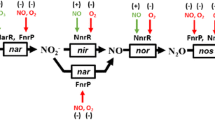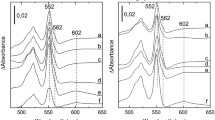Abstract
Paracoccus denitrificans was grown aerobically in chemostat culture in the presence of rotenone. After 6 to 10 generation times, cells showed an oxygen uptake which was completely rotenone-insensitive after removal of rotenone by washing with bovine serum albumin containing medium.
The →H+/O ratio of these cells for endogenous substrates decreased from about 7.50 to 3.95. The latter ratio was similar to the value obtained for starved cells oxidizing exogenous succinate, indicating that site I phosphorylation was absent in these rotenone-insensitive cells.
Membrane particles prepared from these cells showed an 80% decrease in activity of reduced nicotinamide adenine dinucleotide oxidase and reduced nicotinamide adenine dinucleotide-ferricyanide oxidoreductase, while also the kinetic behaviour of the reduced nicotinamide adenine dinucleotide dehydrogenase in the reduced nicotinamide adenine dinucleotide-ferricyanide oxidoreductase assay was changed. Moreover the reduced nicotinamide adenine dinucleotide oxidase activity was practically rotenone-insensitive.
Electron paramagnetic resonance spectroscopy on membrane particles from rotenone-insensitive cells at 15 K revealed that the resonance lines atg z ≈ 2.05 andg y ≈g x ≈ 1.92 arising from iron-sulfur center 2 were undetectable. The intensities of the other electron paramagnetic resonance signals originating from reduced nicotinamide adenine dinucleotide dehydrogenase linked iron-sulfur centers were only slightly diminished.
These observations confirm our previous suggestion that site I phosphorylation, rotenone sensitivity and the presence of iron-sulfur center 2 are correlated.
Similar content being viewed by others
Abbreviations
- EPR:
-
electron paramagnetic resonance
- BSA:
-
bovine serum albumin
- CCCP:
-
carbonylcyanide m-chlorophenylhydrazone
- NAD:
-
nicotinamide adenine dinucleotide
- NADP:
-
nicotinamide adenine dinucleotide phosphate
- ATP:
-
adenosine triphosphate
References
Albracht, S. P. J.: A low-cost cooling device for EPR measurements at 35 GHz down to 4.8° K. J. Magn. Reson.13, 299–303 (1974)
Asano, A., Imai, K., Sato, R.: Oxidative phosphorylation inMicrococcus denitrificans. II. The properties of pyridine nucleotide transhydrogenase. Biochim. Biophys. Acta (Amst.)143, 477–486 (1967)
Beinert, H.: Iron-sulfur centers of the mitochondrial electron transfer system — Recent developments. In: Iron-sulfur proteins, Vol. 3 (W. Lovenberg, ed), pp. 61–100. New York-San Francisco-London: Academic Press 1977
Burnell, J. N., John, Ph., Whatley, F. R.: The reversibility of active sulphate transport in membrane vesicles ofParacoccus denitrificans. Biochem. J.150, 527–536 (1975)
Chang, J. P., Morris, J. G.: Studies on the utilization of nitrate byMicrococcus denitrifucans. J. Gen. Microbiol.29, 301–310 (1962)
Clegg, R. A., Garland, P. B.: Non-haem iron and the dissociation of piericidin A sensitivity from site I energy conservation in mitochondria fromTorulopsis utilis. Biochem. J.124, 135–154 (1971)
Cobley, J. G., Grossman, S., Singer, T. P., Beinert, H.: Piericidin A sensitivity, site I phosphorylation and reduced nicotinamide adenine dinucleotide dehydrogenase during iron-limited growth ofCandida utilis. J. Biol. Chem.250, 211–217 (1975)
Deutsch, C. J., Kula, T.: Transmembrane electrical and pH gradients ofParacoccus denitrificans and their relationship to oxidative phosphorylation. FEBS Lett87, 145–151 (1978)
Edwards, C., Spode, J. A., Jones, C. W.: The growth energetics ofParacoccus denitrificans. FEMS Lett.1, 67–70 (1977)
Fukami, M. H., Light, P. A., Garland, P. B.: Changes of mitochondrial NADH2 oxidation pathways inCandida utilis grown on acetate. FEBS Lett.7, 132–134 (1970)
Garland, P. B.: Biochemical applications of continuous culture: energy-conservation mechanisms inTorulopsis utilis. Biochem. J.118, 329–339 (1970)
Garland, P. B., Clegg, R. A., Downie, J. A., Gray, T. A., Lawford, H. G., Skyrme, J.: Is the NADH dehydrogenase looped? In: Mitochondria: Biogenesis and bioenergetics. Biomembranes: Molecular arrangements and transport mechanisms (S. G. van der Bergh, P. Borst, L. L. M. van Deenen, J. C. Riemersma, E. C. Slater, J. M. Tager, eds.), pp. 105–117. Amsterdam: North-Holland, American Elsevier 1972
Gray, T. A., Garland, P. B., Lowe, D. J., Bray, R. C.: Electronparamagnetic resonance spectroscopy studies of iron-sulphur centres of submitochondrial particles of iron- and sulphurdeficientCandida utilis. Biochem. J.146, 239–246 (1975)
Grossman, S., Cobley, J. G., Singer, T. P., Beinert, H.: Reduced nicotinamide adenine dinucleotide dehydrogenase, piericidin sensitivity, and site I phosphorylation in different growth phases ofCandida utilis. J. Biol. Chem.249, 3819–3826 (1974)
Gutman, M., Singer, T. P., Casida, J. E.: Studies on the respiratory chain-linked reduced nicotinamide adenine dinucleotide dehydrogenase. XVII. Reaction sites of piericidin A and rotenone. J. Biol. Chem.245, 1992–1997 (1970)
Haddock, B. A., Garland, P. B.: Effect of sulphate-limited growth on mitochondrial electron transfer and energy conservation between reduced nicotinamide — adenine dinucleotide and the cytochromes inTorulopsis utilis. Biochem. J.124, 155–170 (1971)
Horgan, D. J., Singer, T. P., Casida, J. E.: Studies on the respiratory chain-linked reduced nicotinamide adenine dinucleotide dehydrogenase. XIII. Binding sites of rotenone, piericidin A, and amytal in the respiratory chain. J. Biol. Chem.243, 834–843 (1968)
Imai, K., Asano, A., Sato, R.: Oxidative phosphorylation inMicrococcus denitrificans. V. Effects of iron deficiency on respiratory components and oxidative phosphorylation. J. Biochem. (Tokyo)63, 219–225 (1968)
John, Ph., Whatley, F. R.: Oxidative phosphorylation coupled to oxygen uptake and nitrate reduction inMicrococcus denitrificans. Biochim. Biophys. Acta (Amst.)216, 342–352 (1970)
John, Ph., Whatley, F. R.: The bioenergetics ofParacoccus denitrificans. Biochim. Biophys. Acta (Amst.)463, 129–153 (1977)
Jones, C. W.: Aerobic respiratory systems in bacteria. In: Microbial energetics (B. A. Haddock, W. A. Hamilton, eds.), pp. 23–59. Cambridge: Cambridge University Press 1977
Jones, C. W., Brice, J. M., Downs, A. J., Drozd, J. W.: Bacterial respiration-linked proton translocation and its relationship to respiratory-chain composition. Europ. J. Biochem.52, 265–271 (1975)
Jones, C. W., Brice, J. M., Edwards, C.: The effect of respiratory chain composition on the growth efficiencies of aerobic bacteria. Arch. Microbiol.115, 85–93 (1977)
Kaplan, N. O.: Pyridine nucleotide transhydrogenase. In: Methods in enzymology, Vol. 2 (S. P. Colowick, N. O. Kaplan, eds.), pp. 681–687. New York: Academic Press 1955
Lawford, H. G., Cox, J. C., Garland, P. B., Haddock, B. A.: Electron transport in aerobically grownParacoccus denitrificans: Kinetic characterization of the membrane-bound cytochromes and the stoichiometry of respiration-driven proton translocation. FEBS Lett.64, 369–374 (1976)
Light, P. A., Garland, P. B.: A comparison of mitochondria fromTorulopsis utilis grown in continuous culture with glycerol, iron, ammonium, magnesium or phosphate as the growth-limiting nutrient. Biochem. J.124, 123–134 (1971)
Light, P. A., Ragan, C. I., Clegg, R. A., Garland, P. B.: Iron-limited growth ofTorulopsis utilis, and the reversible loss of mitochondrial energy conservation at site I and of sensitivity to rotenone and piericidin A. FEBS Lett.1, 4–8 (1968)
Lowry, O. H., Rosebrough, N. J., Farr, A. L., Randall, R. J.: Protein measurements with the Folin phenol reagent. J. Biol. Chem.193, 265–275 (1951)
Lundin, A., Aasa, R.: A simple device to maintain temperatures in the range 4.2–100 K for EPR measurements. J. Magn. Reson.8, 70–73 (1972)
Meijer, E. M., van Verseveld, H. W., van der Beek, E. G., Stouthamer, A. H.: Energy conservation during aerobic growth inParacoccus denitrificans. Arch. Microbiol.112, 25–34 (1977a)
Meijer, E. M., Wever, R., Stouthamer, A. H.: A study of iron-sulphur proteins in the respiratory chain ofParacoccus denitrificans. Proc. Soc. Gen. Microbiol.4, 77 (1977b)
Meijer, E. M., Wever, R., Stouthamer, A. H.: The role of iron-sulfur center 2 in electron transport and energy conservation in the NADH-ubiquinone segment of the respiratory chain inParacoccus denitrificans. Eur. J. Biochem.81, 267–275 (1977c)
Mitchell, P.: Chemiosmotic coupling in oxidative and photosynthetic phosphorylation. Biol. Rev.41, 445–502 (1966)
Mitchell, P., Moyle, J.: Respiration driven proton translocation in rat liver mitochondria. Biochem. J.105, 1147–1162 (1967)
Ohnishi, T.: Studies on the mechanism of site I energy conservation. Eur. J. Biochem.64, 91–103 (1976)
Ohnishi, T.: Mechanism of electron transport and energy conservation in the site I region of the respiratory chain. Biochim. Biophys. Acta (Amst.)301, 105–128 (1973)
Ohnishi, T.: Thermodynamic and EPR characterization of iron-sulfur centers in the NADH-ubiquinone segment of the mitochondrial respiratory chain in pigeon heart. Biochim. Biophys. Acta (Amst.)387, 475–490 (1975)
Ohnishi, T., Asakura, T., Yonetani, T., Chance, B.: Electron paramagnetic resonance studies at temperatures below 77° K on iron-sulfur proteins of yeast and bovine heart submitochondrial particles. J. Biol. Chem.246, 5960–5964 (1971)
Ohnishi, T., Asakura, T., Wohlrab, H., Yonetani, T., Chance, B.: Electron paramagnetic studies on iron-sulfur proteins of submitochondrial particles fromCandida utilis cells. J. Biol. Chem.245, 901–902 (1970)
Orme-Johnson, N. R., Hansen, R. E., Beinert, H.: Electron paramagnetic resonance-detectable electron acceptors in beef heart mitochondria. Ubihydroquinone-cytochromec reductase segment of the electron transfer system and complex mitochondrial fragments. J. Biol. Chem.249, 1928–1939 (1974a)
Orme-Johnson, N. R., Orme-Johnson, W. H., Hansen, R. E., Beinert, H.: EPR detectable electron acceptors in submitochondrial particles from beef heart with special reference to the iron-sulfur components of DPNH-ubiquinone reductase. Biochem. Biophys. Res. Commun.58, 178–184 (1974b)
Orme-Johnson, N. R., Orme-Johnson, W. H., Hansen, R. E., Beinert, H., Hatefi, Y.: EPR detectable electron acceptors in submitochondrial particles from beef heart with special reference to the iron-sulfur components of DPNH-ubiquinone reductase. Biochem. Biophys. Res. Commun.44, 446–453 (1971)
Scholes, P. B., Mitchell, P.: Respiration-driven proton translocation inMicrococcus denitrificans. J. Bioenerg.1, 309–323 (1970)
Singer, T. P., Gutman, M.: The DPNH dehydrogenase of the mitochondrial respiratory chain. In: Advances in enzymology, Vol. 34 (F. F. Nord, ed.), pp. 79–153. New York-London-Sidney-Toronto: Interscience 1971
van Verseveld, H. W., Meijer, E. M., Stouthamer, A. H., Energy conservation during nitrate respiration inParacoccus denitrificans. Arch. Microbiol.112, 47–23 (1977)
van Verseveld, H. W., Stouthamer, A. H.: Oxidative phosphorylation inMicrococcus denitrificans. Calculation of the P/O ratio in growing cells. Arch. Microbiol.107, 241–247 (1976)
van Verseveld, H. W., Stouthamer, A. H.: Electron-transport chain and coupled oxidative phosphorylation in methanol-grownParacoccus denitrificans. Arch. Microbiol.118, 13–20 (1978)
Wever, R., van Drooge, J. H., van Ark, G., van Gelder, B. F.: Biochemical and biophysical studies on cytochromec oxidase. XVII. An EPR study of the photodissociation of cytochromea 2+3 · CO. Biochim. Biophys. Acta (Amst.)347, 215–223 (1974)
Witholt, B., Boekhout, M., Brock, M., Kingma, J., van Heerikhuizen, H., de Leij, L.: An efficient and reproducible procedure for the formation of spheroplasts from variously grownEscherichia coli. Anal. Biochem.74, 160–170 (1976)
Author information
Authors and Affiliations
Rights and permissions
About this article
Cite this article
Meijer, E.M., Schuitenmaker, M.G., Boogerd, F.C. et al. Effects induced by rotenone during aerobic growth ofParacoccus denitrificans in continuous culture. Arch. Microbiol. 119, 119–127 (1978). https://doi.org/10.1007/BF00964262
Received:
Issue Date:
DOI: https://doi.org/10.1007/BF00964262




